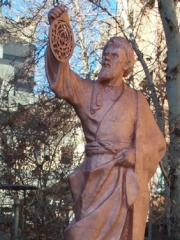

The Most Famous
MATHEMATICIANS from Turkmenistan
This page contains a list of the greatest Turkmen Mathematicians. The pantheon dataset contains 1,004 Mathematicians, 2 of which were born in Turkmenistan. This makes Turkmenistan the birth place of the 38th most number of Mathematicians behind Argentina, and New Zealand.
Top 2
The following people are considered by Pantheon to be the most legendary Turkmen Mathematicians of all time. This list of famous Turkmen Mathematicians is sorted by HPI (Historical Popularity Index), a metric that aggregates information on a biography's online popularity.

1. Muhammad ibn Musa al-Khwarizmi (780 - 850)
With an HPI of 90.62, Muhammad ibn Musa al-Khwarizmi is the most famous Turkmen Mathematician. His biography has been translated into 148 different languages on wikipedia.
Muhammad ibn Musa al-Khwarizmi, or simply al-Khwarizmi (c. 780 – c. 850) was a mathematician active during the Islamic Golden Age, who produced Arabic-language works in mathematics, astronomy, and geography. Around 820, he worked at the House of Wisdom in Baghdad, the contemporary capital city of the Abbasid Caliphate. One of the most prominent scholars of the period, his works were widely influential on later authors, both in the Islamic world and Europe. His popularizing treatise on algebra, compiled between 813 and 833 as Al-Jabr (The Compendious Book on Calculation by Completion and Balancing), presented the first systematic solution of linear and quadratic equations. One of his achievements in algebra was his demonstration of how to solve quadratic equations by completing the square, for which he provided geometric justifications. Because al-Khwarizmi was the first person to treat algebra as an independent discipline and introduced the methods of "reduction" and "balancing" (the transposition of subtracted terms to the other side of an equation, that is, the cancellation of like terms on opposite sides of the equation), he has been described as the father or founder of algebra. The English term algebra comes from the short-hand title of his aforementioned treatise (الجبر Al-Jabr, transl. "completion" or "rejoining"). His name gave rise to the English terms algorism and algorithm; the Spanish, Italian, and Portuguese terms algoritmo; and the Spanish term guarismo and Portuguese term algarismo, all meaning 'digit'. In the 12th century, Latin translations of al-Khwarizmi's textbook on Indian arithmetic (Algorithmo de Numero Indorum), which codified the various Indian numerals, introduced the decimal-based positional number system to the Western world. Likewise, Al-Jabr, translated into Latin by the English scholar Robert of Chester in 1145, was used until the 16th century as the principal mathematical textbook of European universities. Al-Khwarizmi revised Geography, the 2nd-century Greek-language treatise by Ptolemy, listing the longitudes and latitudes of cities and localities. He further produced a set of astronomical tables and wrote about calendric works, as well as the astrolabe and the sundial. Al-Khwarizmi made important contributions to trigonometry, producing accurate sine and cosine tables.

2. Alī ibn Ahmad al-Nasawī (1010 - 1075)
With an HPI of 61.82, Alī ibn Ahmad al-Nasawī is the 2nd most famous Turkmen Mathematician. His biography has been translated into 17 different languages.
Alī ibn Aḥmad al-Nasawī (Persian: علی بن احمد نسوی; c. 1011 possibly in Khurasan – c. 1075 in Baghdad) was a Persian mathematician from Khurasan, Iran. He flourished under the Buwayhid sultan Majd al-dowleh, who died in 1029-30AD, and under his successor. He wrote a book on arithmetic in Persian, and then Arabic, entitled the "Satisfying (or Convincing) on Hindu Calculation" (al-muqni fi-l-hisab al Hindi). He also wrote on Archimedes's Book of Lemmas and Menelaus's theorem (Kitab al-ishba, or "satiation"), where he made corrections to the Book of Lemmas as translated into Arabic by Thabit ibn Qurra and last revised by Nasir al-Din al-Tusi. Al-Nasawī's arithmetic explains the division of fractions and the extraction of square and cubic roots (square root of 57,342; cubic root of 3, 652, 296) almost in the modern manner. Al-Nasawī replaces sexagesimal by decimal fractions. Al-Nasawī criticises earlier authors, but in many cases incorrectly. His work was not original, and he sometimes writes of matters that he does not understand, e.g. "borrowing" in subtraction. Ragep and Kennedy also give an analysis of a mid-12th-century manuscript in which a summary of Euclid's Elements exists by al-Nasawī.
People
Pantheon has 2 people classified as Turkmen mathematicians born between 780 and 1010. Of these 2, none of them are still alive today. The most famous deceased Turkmen mathematicians include Muhammad ibn Musa al-Khwarizmi, and Alī ibn Ahmad al-Nasawī.

